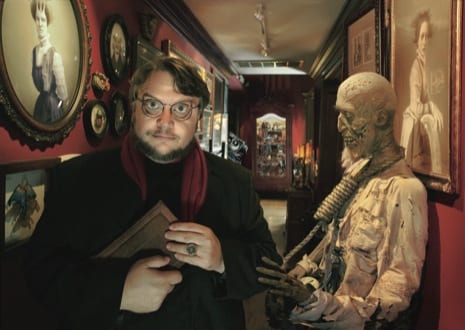On things for certain, the 19th century gave us a lot in terms of new literature genres and tropes that still inspire us today. Indeed the 19th century was the century of the novel, and since a good section of our movies/TV shows are based on novels, it is not surprising to find that our current media is heavily influenced by this area. Hulk borrows from Dr. Jekyll and Mr. Hyde. Dracula features films all over the place. The ill-regarded Penny Dreadful genre gave its name to a respected TV show. Every Jane Austen book has been adapted at least twice. We still try to shoehorn Hugo or Zola’s works into two hours movies. And so on…
There’s nothing wrong with this. Using well-analyzed 19th century literature as a source of inspiration or even directly adapting acclaimed works to the silver screen has as much merit as bastardizing another young adult book. As long as one recognizes that 19th century literature wasn’t exempt from problematic tropes, of course.
The dichotomy between Meena/Lucy in Dracula is very much a virgin/whore one. Guess who doesn’t survive at the end of the book? Dracula himself is a Count, a title that doesn’t exist in England, because foreigner amiwright? Hyde is monkey-like because a person’s propensity to criminal deeds is definitively shown on their face. The more animal-like they look, the more dangerous they are (cue eyerolling). Oh, and free women bring ruin to men and, finally, they die.
I could go on and on with every thing that 19th century did really poorly, but let’s just say that women where a ‘strange species’ for the massively male dominating writing world. (There is a reason why Amantine Aurore Lucile Dupin went by the pen name George Sand, for example.) They have to be pure and content with their lot, else they would be punished. Punished even if they save the day. There is no way a woman would have a heroic role if it wasn’t a tragic one. And God forbid they have any sexual drive. That’s not what women do. It’s actually better to have them die of tuberculosis.
That’s one of my main problem with taking inspiration from 19th century literature. When coming across these harmful tropes, the common reaction of a lot of modern writers is:
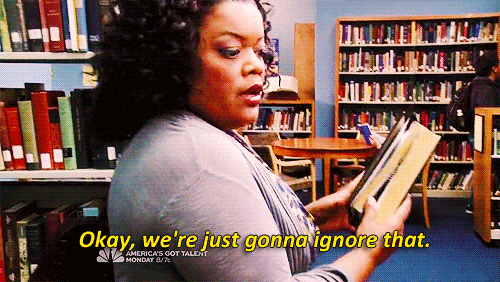
It’s my big problem with gothic stories in particular.
The Gothic Genre, My Beautiful Problematic Fave
The gothic genre, which began in the 18th century but gained in popularity in the 19th century, is a very English (and American) thing. I guess when your country has normal seasons the suspension of disbelief required to have rich people continuing to live in a permanently foggy area is a bit too much. Or, if your country has a Catholic culture you might not understand this fetishizing of Evil CatholicTM. Gotta appreciated the idea that Gothic novels are “saturated by superstitious beliefs, including Catholicism”. Excuse me, Catholicism is not a superstition it’s a well organized religion that existed well before Protestantism and is actually the most widespread Christian denomination in the world.
Anyway, gothic novels always revolve around a mystery and may include elements more common to fantasy (though there is always a fantastical ambiance). According to this British Library article, the most common themes are,
- Strange places: the setting of the main story will be a strange and mysterious place. It is often threatening or violent, sometimes sexually enticing, often a prison.
- Clashing time periods
- Power and constraint: more precisely, violent differences in power that include entrapment and forced actions. Scenes of extreme threat and isolation are always happening or about to happen.
- Terror
- A world of doubt: primarily, this centers on doubt about the paranormal, a power beyond human comprehension, in order to make the reader uncertain.
One of the sub-genres of the gothic novel is the gothic romance. It features one of my least favorite tropes of all time: the pure naive (nice word for not very smart) maiden who saves her doomed, much older love interest. Key word here being maiden who should not follow through on any sexual urges (or at least not out of wedlocks). Of course her love interest is usually a massive dick (hi, M. Rochester, locking up your wife in the attic because she is mentally ill is not a forgivable offense, I understand why she wants to kill you). Not to say that it cannot be done correctly or even be enticing. But, when I see modern authors trying to write a modern gothic romance, this is my reaction:
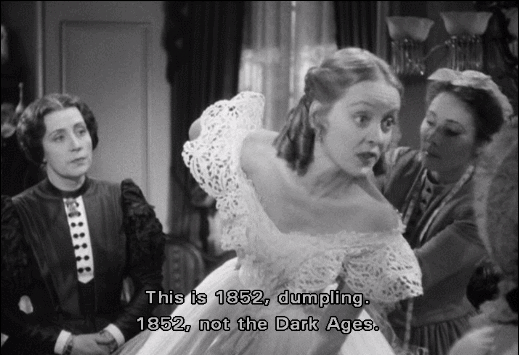
And all of this charming exposition leads us to today’s subject: Crimson Peak or, how to subvert a genre’s tropes respectfully.
Crimson Peak, the Modern Gothic Romance we Needed
Crimson Peak is a 2015 film that has the extreme advantage to be directed by bestpersonever Guillermo del Toro and includes a cast I love to death. It follows the story of Edith Cushing who goes to England with her new husband Thomas Sharpe and his sister, Lucille, after her father has been mysteriously murdered. Of course the Sharpe’s manor, Crimson Peak, is very mysterious and seems to be inhabited by ghosts.
Gothic themes are you there?
Well first if you look at the general aesthetic of the movie what you will see it is every gothic fan’s wet-dream.
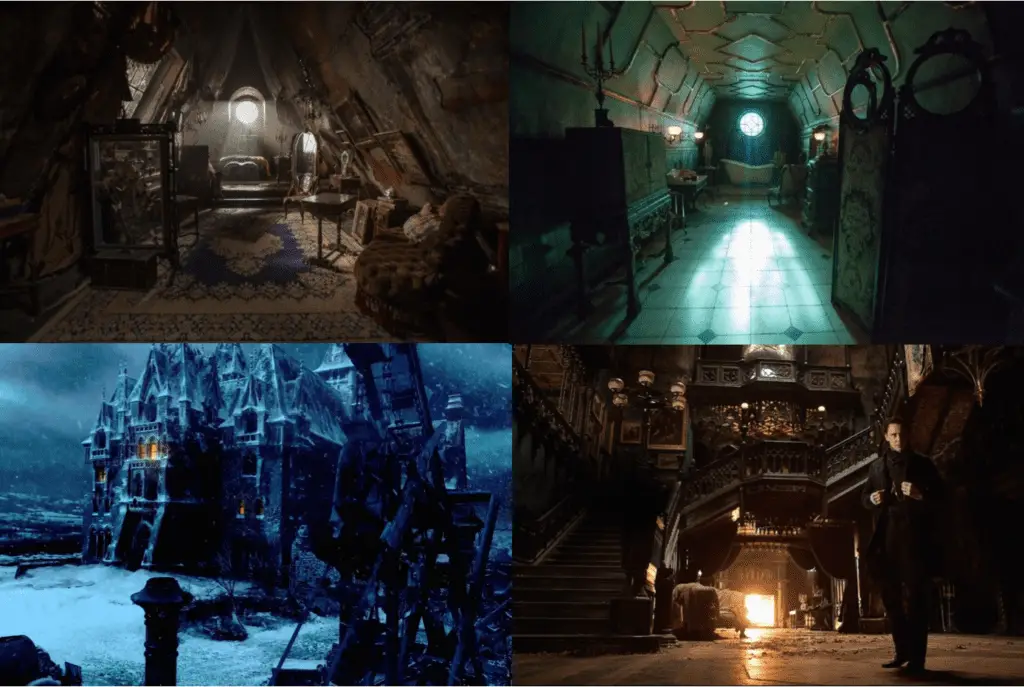
But it has to go a bit deeper than just visual aesthetic. Is Crimson Peak a gothic story?
Well, as you might have noticed from my carefully written synopsis, there are a lot of mysteries to uncover in Crimson Peak. It also clearly captures the fantastical ambiance with the apparition of ghosts. But to say that the ghosts are real well… Let’s say that once again it’s the same dilemma as in Pan’s Labyrinth. The fantasy elements play too significant a role for the viewer to dismiss them as unreal, but only one character actually interact with them so. Beyond that, in Crimson Peak the manor was not haunted before Edith’s arrival, so they’re obviously connected to her in an intimate way.
What about the concept of strange place? Well, Edith is brought to the old continent where she knows no one. The manor itself holds its lot of mysteries. She is stuck there and tries to escape, so it also plays the role of informal prison. And the atmosphere is threatening and violent, borderline gory, for the final act. So far, Crimson Peak is ticking every box on the gothic checklist.
The theme clashing time periods is more subtle. It clashes with ours, certainly, but it is contemporaneous with the glory days of the historic genre. Still, not only is this area alien to us as viewers, it also is for Edith, who came from the ‘modern’ America and ends up in the aristocratic England. One world is presented at its beginning (America) with Edith father’s having made his fortune there in the building industry. The other, aristocratic England, is literally a dying world (nothing grows there) with a decadent society, incest being one of the metaphorical representation of decadence. So we do, in fact, have clashing time periods both for the audience and the heroine.
There are also clear power imbalances in the movie. The moment Edith sets foot in the manor she is under the Sharpes’ control. This is represented by only Lucille having the house’s key, which prevents Edith from being the mistress of the house. It’s also shown through the slow physical deterioration of Edith, who ends up needing Lucille and Thomas to help her move.
In terms of terror well… Let’s say that if the ghosts do end up being non-aggressive, they sure don’t feel that way most of the film.
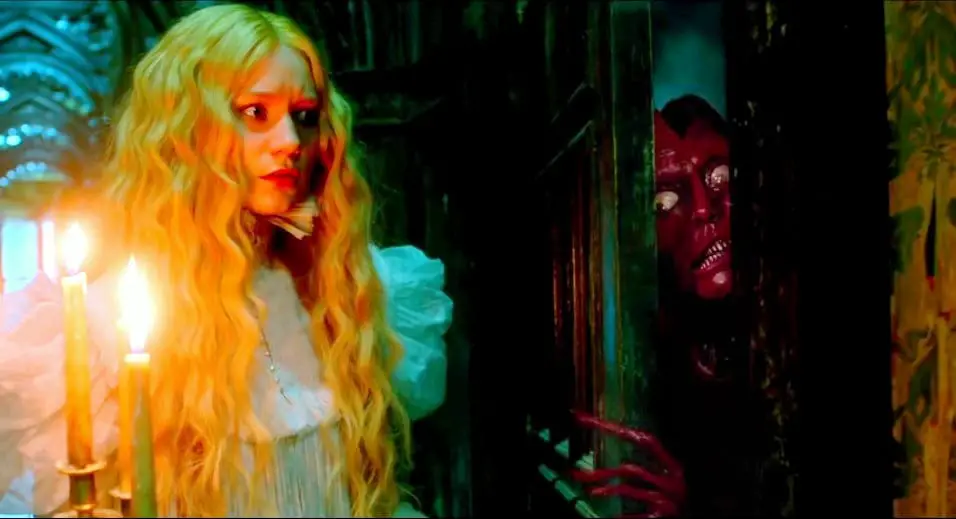
Finally, Crimson Peak ticks its last box, a world of doubt, quite masterfully. Are the ghost real? Is Thomas in love with Edith or is it all an act? Is Lucille sane? Is the closeness between Thomas and Lucille normal? So many questions, so many doubt for Edith.
There is no doubt that Crimson Peak is a gothic story. Some might argue about the romance part, but Guillermo del Toro knows what a gothic story is and not every gothic story is a gothic romance.
However, he also knows how to not be a 19th century man.
Deconstruction of Gothic Tropes
Sex is a positive thing?
The first absolutely non-traditional gothic story element that came to mind is that positive female sexuality is framed, well, positively. This is made even more obvious by the fact that male sexuality is almost non-existant in this movie. Men only sexually exist in Crimson Peak to satisfy women. Which begs the question: who is Guillermo del Toro and why is he so cool?
Don’t believe me? Keep reading.
At the beginning of the movie Edith runs into the local upper class women, aka, the local bullies. They laugh at her desire to become a published writer saying that she is going to become an old spinster like Jane Austen. Threatening a woman with eternal celibacy was, in a way, threatening her with eternal chastity. In more modern terms, it’s a way of saying “You’re too weird, nobody wants to fuck you”. Not nice.
How does Edith answer? She wants to be a widow like Mary Shelley. Not only does Edith reaffirm that she can be married, but also that she wouldn’t mind a very scandalous marriage. Furthermore, the idea of wanting to be a widow put her in a sort of predatory position vis-à-vis her matrimonial status. One could go so far as saying a dominating position and one traditionally reserved to the husband in heterosexual marriage. The husband who is supposed to be the sexual being in the couple, not the wife. Basically, in terms of subtext, the scene can be read as Edith saying, “I will marry and have hot sex with my husband who will conveniently die when I don’t fancy him anymore.”
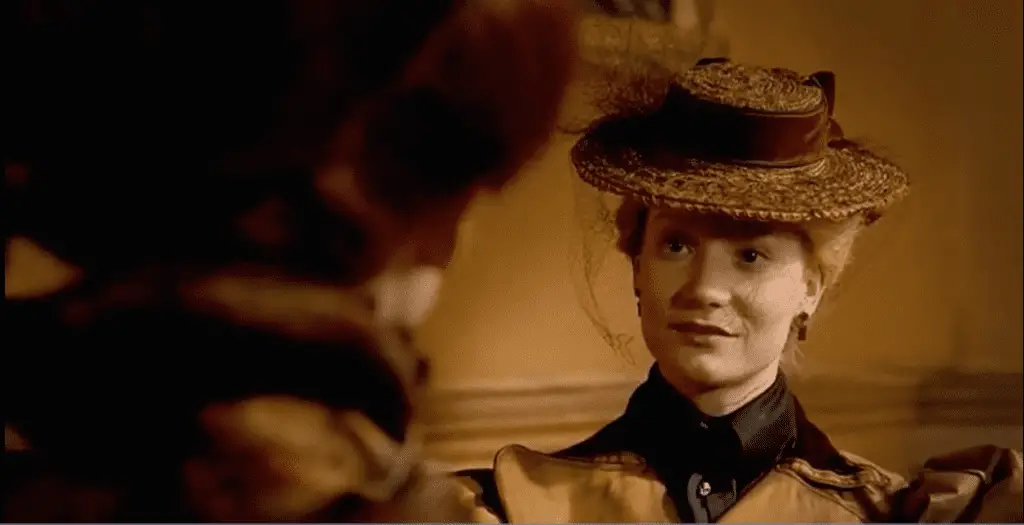
Then there is the sex scene of the movie. At the post office (in a private room where they have to spent the night you pervert!), Edith finally manages to convince her husband to do his matrimonial duty, and its framed as a positive thing. For both characters. According to Edith herself, its the way of going forward. It certainly triggers a change for the better in Thomas.
A round of applause for a gothic story featuring female sexuality as something positive!
Edith, a Woman with Ambition
Edith starts the movie in a different mental states than most heroines. She already knows what she wants, but not like a Disney princess who wants more than this common life. No, she knows that she wants to be a published writer and is actively working toward that goal.
Even better, the men in her life—her father and Alan, her childhood friend—actively encourage her to pursue her dream. Her father even helps her by getting her appointments with editors. Most of all, the symbolic gift of the pen is the most important help he gives her. Because her father attaches importance to her having the right tool. I am especially fond of Edith’s relationship with her father. It is very loving, respectful, and caring.
But let’s get back to the topic of Edith wanting something from life. After her father’s death, she marries Thomas and for the rest of movie she puts her initial goal aside. Then comes the show-down, and what gets her out of the inescapable situation she is in? The pen. The gift she initially dismissed but represented her ambition. The trust her loved ones put in it came to her rescue.
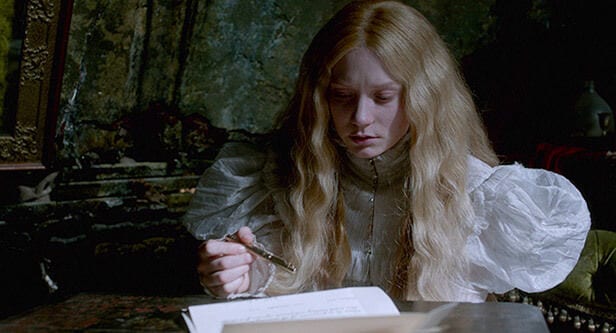
Having a woman saved by her ambition? I am crying because this is so beautiful.
A Women Driven Story
The ultimate blow to the sexist elements of the gothic genre is that women drive the plot entirely. Men exist as means to women’s ends. And when they try to be proactive they end up needing rescue.
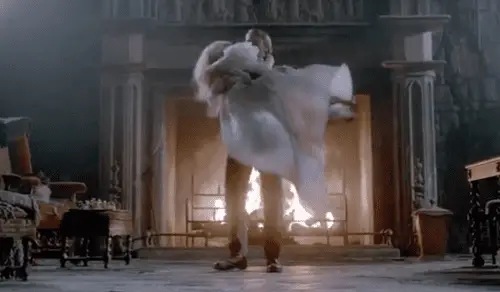
It boils down to the opposition between Lucille and Edith. Edith is a sunny personality who is ready to fight and create to get the life she wants. Lucille, on the other hand, is a nocturnal person who uses crime to pursue a dying life style. Her past and her demons are consuming her and she is becoming an integral part of the house. That’s why she can’t find love outside of her brother. That’s why she doesn’t believe that his industrial project will work.
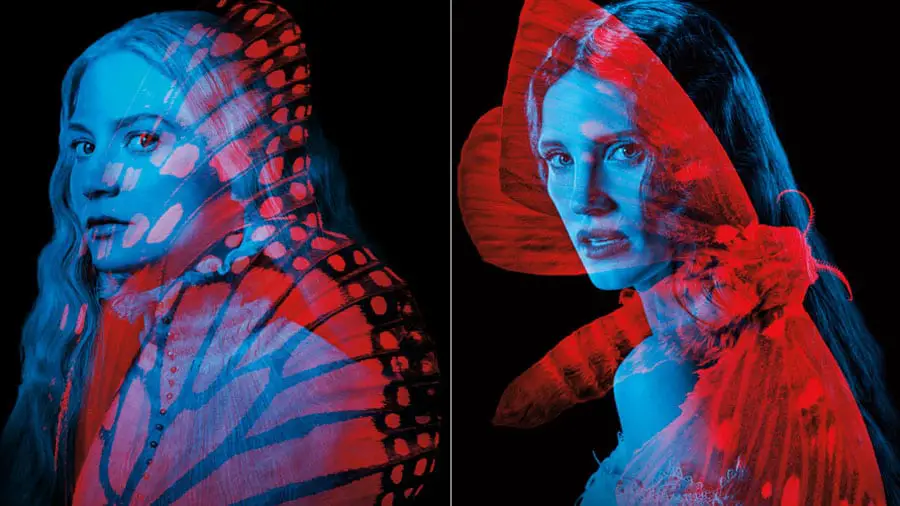
Lucille is Edith’s opponent and Thomas is only the means for the conflict to happen. The movie only concludes after Edith defeats Lucille.
Even the ghosts are all women as well as vectors of truth and caution. The ghosts are the women Lucille has defeated and end up being helpful allies to Edith. Oh, and Edith saves herself.
In a way, Lucille is treated as a male villain. She could have easily fallen into the ‘crazy bitch’ stereotype, but the story explains and ‘justifies’ her evil deeds as it would do with a personal favorite white boy character. Lucille actually ended-up being well-liked in the fandom.
Women do things in Crimson Peak, men suffer from them. Of course I don’t want to see that in every movie but it is refreshing to see a movie that manages to focus on women, and on women who occupy the biggest roles: the protagonist and antagonist. Even more so when the original genre tends to be a tad sexist.
So yeah, it is perfectly possible to take a genre full of harmful tropes and make a solid and respectful work out of it without falling head first in stereotypes. You just have to do things seriously, like Guillermo del Toro does.
